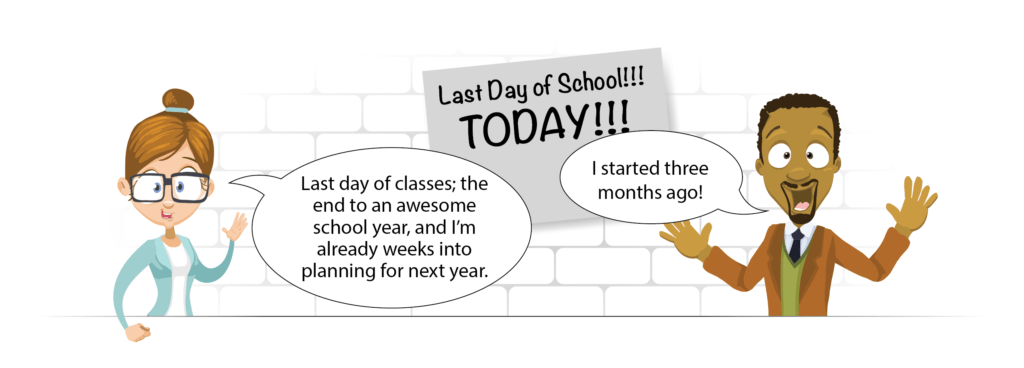The Summer Period
After the first year of working with the Rhythm of the Learner Year, it’s possible to develop a effective and efficient plan for summer activities. Most of the academic leaders and teachers will have moved from the awareness level to at least the practitioner level and might be ready to move on to the mastery level. Students and staff will have had a year’s experience working with effective student work and formative student assessments. For teachers, this refers to the design and engagement of students in the work and assessments. For students, it refers to learning and to be highly engaged in assigned work and completing all tasks: developing the habits of mind, attitudes, and perceptions that support effective learning

Rhythm of the Learner Year Timeline


The second combines everything from a leader’s first summer period (mostly focused on systems, facilities, and planning) and adds new layers of data collection, teacher evaluation, causal analysis of student performance, and more in-depth planning for opening school. Once leadership has been through and entire cycle of the Learner Year, causal data, planning, and monitoring become critical to continued success. Leadership must both continue to expand the depth of knowledge of the current teachers as well as prepare for how to onboard new faculty and support staff. As this process is understood and institutionalized at a school, leadership can push more of the planning and accountability down to academic coaches, teachers, and, in terms of progress monitoring and self-assessment, the students. This second Summer Period chapter has more tools and strategies.
Timeframe
like the first Summer Period, Summer 2 is divided into two sub periods. The first sub period (first half of summer) is devoted to an analysis of what did and didn’t work the previous year. This period begins with the end of the student year and lasts three to four weeks into the summer.
Goals
After the first year of working with the Rhythm of the Learner Year, the focus continues on the development of school capacity to move students. To use both periods of the summer for best practice activities for the administrative team, teaching, and support staff and the students themselves. The largest difference between the Summer 1 and Summer 2, is that leadership is using a much larger and more targeted data set as well as a year of practical knowledge of planning based on student work and teaching the whole child with the 5 Legged model. The facilities and operational readiness are still high priorities, but the closing out year 1 and the preparation for year 2 can be much more nuanced in curricula planning, professional development, data collection planning and how to on board new faculty and support staff so everyone plays his or her part in supporting leadership’s plans and goals.
Priorities for the Formative Period
Academic Leaders
- Complete an in-depth analysis of each period of the academic year to determine the extent to which the school plan was implemented and the impact of that implementation on student performance.
- Provide training and developmental experience for academic leaders to move them from awareness and practitioner level to mastery level.
- Provide training for teachers and support staff to move from awareness level to at least practitioner level and target some for a leadership development experience set.
- Provide a menu of student activities that can expand student language or experience base, maintain performance levels, or build life experience for students who have limited experience.
- Provide programs that build access to decision making for all staff and help build both top-down and bottom-up access to problem solving and decision making.
- Develop a strategic plan that can be turned into tactical plans by all staff.
- Plan for an opening of school that includes best practice opportunities for students and staff to start the year successfully.
- Sort and place students to create effective teaching and learning teams.
- Get the facilities, materials, and technologies in efficient working order.
- Plan and provide orientation programs for all new parents and staff and for all students with their new teachers.
- Evaluate and upgrade management and academic systems.
- Provide the ad hoc PD needed to prepare staff to lead learners and learning teams.
- Complete an evaluation of the Opening Period, Formative Period, and Calibrating Period.
School Teachers
- Evaluate the year, identifying successes and failures and revise plans.
- Plan summer activities and growth opportunities.
- Collect student profiles and begin identifying “at risk” students.
- Plan the rituals and routines, orientation, and initial learning activities for next year’s opening.
- Develop a scaffold for next year’s units, establish learning goals for each unit, and prepare the formative student work for the first work units.
- Collect final data points and final student profile student metadata.

Interested in Reading the Book?
This book is the aggregation of the research and fieldwork that has gone into our approach to working with struggling schools as well as adding value to blue ribbon schools. We tried to write it in a step-by-step, show your math, chunked out format so that if the leadership team were never able to attend an Ed Directions PD, they could still plan and monitor their school year with the student-focused understanding of the Rhythm of the Learner Year in mind.

